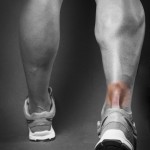
A friend of the Elf has been suffering for some time with pain in the middle of their achilles tendon and as they are usually an active person it has been affecting their function. They have been in the gym undertaking some eccentric exercises (exercises where the muscles are lengthened against a load) but wondered if their programme is most effective.
So we searched the evidence and we found a recent systematic review by Habets and van Cringel that investigated which eccentric exercise training (EET) parameters are most effective for pain and patient-reported function in patients with chronic mid-portion achilles tendinopathy (AT).
Here’s what they did
The authors used a detailed search strategy to search the following electronic databases MEDLINE, EMBASE, CINAHL and Cochrane Central Register for Controlled Trials (CENTRAL) for Randomised Controlled Trials (RCTs) and Controlled Clinical Trials (CCTs) up to February 2013. They also used reference tracking of included studies and other reviews. For adults with chronic (over 3 months) symptoms of mid-portion Achilles tendinopathy.
Three authors independently reviewed, data abstracted and quality assessed each study using the PEDro scale and a score of ≥ 6/10 was considered high methodological quality and 5/10 or lower low methodological quality. Risk of bias was assessed using the Cochrane Collaboration’s tool.
Here’s what they found
- They included 14 studies involving 794 participants (of which 389 received exercise interventions)
- The average age was 32 – 54 years and included athletes and non-athletes
- 6 of the 14 studies were considered high quality
- no uniformity in the exercise protocols was observed
- 3 studies reported good compliance with the exercise programme (75% exercises performed in 26-72% of participants)
- all studies (except one) reported significant improvements for interventions
- As studies used different outcome measures only descriptive analysis was possible
- Pain and function
- Strong evidence for the original Alfredson eccentric protocol (3 high-quality studies)
- Strong evidence (2 high-quality studies) to support the use of a gradual onset of exercises during the first week
- Moderate evidence was found for the different protocols that were used in other 9 studies
The authors concluded
Traditionally, the Alfredson protocol has been used in many studies, but this review showed that other protocols may achieve similar results for pain and function.
The Musculoskeletal Elf’s view

The Alfredson protocol is based on a small prospective study published in 1998 that reported the results of heavy-load eccentric calf muscle training in 15 recreational athletes compared with 15 people treated conservatively. They reported that in no case was the conventional treatment successful, and all patients were ultimately treated surgically. They concluded that the treatment model with heavy-load eccentric calf muscle training has a very good short-term effect on athletes in their early forties. However this study has many methodological weaknesses but the Alfredson protocol appears to be widely used in clinical practice. Therefore this systematic review sought to investigate the effects of different protocols for this patient group on pain and function.
The different outcome measures used by the studies included in this systematic review meant that meta-analysis was not possible. Several studies included in this systematic review used the VISA-A scale (Victorian Institute of Sport Assessment-Achilles Questionnaire). This is an easily self-administered questionnaire that evaluates symptoms and their effect on physical activity and has good validity and reliability.
What do you think?
- If you use the Alfredson protocol do you use the original or a modified version?
- What eccentric exercise training protocol do you use for this population?
- How much resistance, how many reps, bent or straight knee, what speed, how many sessions?
- How do you assess the outcome of treatment for this population?
Send us your views on this blog and become part of the ever expanding Musculoskeletal Elf community. Post your comment below, or get in touch via social media (Facebook, Twitter, LinkedIn, Google+).
Links
- Habets B, van Cingel RE. Eccentric exercise training in chronic mid-portion Achilles tendinopathy: a systematic review on different protocols. Scand J Med Sci Sports. 2015 Feb;25(1):3-15. doi: 10.1111/sms.12208. Epub 2014 Mar 20. [abstract]
- Alfredson H, Pietilä T, Jonsson P, Lorentzon R. Heavy-load eccentric calf muscle training for the treatment of chronic Achilles tendinosis.Am J Sports Med. 1998 May-Jun;26(3):360-6. [abstract]
- Robinson JM, Cook JL, Purdam C, Visentini PJ, Ross J, Maffulli N, Taunton JE, Khan KM; Victorian Institute Of Sport Tendon Study Group. The VISA-A questionnaire: a valid and reliable index of the clinical severity of Achilles tendinopathy. Br J Sports Med. 2001 Oct;35(5):335-41. [abstract]
- PRISMA statement
- EQUATOR Network
Acknowledgements
This blog was written in discussion with the following experienced physiotherapists undertaking an MSc programme at Glasgow Caledonian University; Charlotte Boyer, Elena Ierardi, Beatric Sankah and Ilona Malkauskaite.


Which eccentric exercises are most effective for pain and function in chronic mid-portion achilles tendinopathy? http://t.co/4rAK2bcOyN
Which eccentric exercises are most effective for pain and function in chronic mid-port… http://t.co/DGtfYKpLwL http://t.co/S9Em99Ltck
Eccentric exercise for chronic mid portion achilles tendinopathy http://t.co/JdID7oY6Yz
Which ones then ?
Might not be that eccentric exercise is even the ideal intervention…
http://www.ncbi.nlm.nih.gov/pubmed/26018970/
Is life not eccentric enough? For achillestendons it certainly is ! eccentric exercise is not my first choise of treatment by achillestendinopathy!
If you use the Alfredson protocol do you use the original or a modified version? – I use an adapted protocol (eccentric step stretch) which my Sports Physician gave me.
How much resistance, how many reps, bent or straight knee, what speed, how many sessions? Find a suitable step to stand upright (you should have no bend at your waist) whith heels over the edge of the step (you should be on the balls of your feet) and lower yourself down over the step. Use wall to balance. Each stretch should last 15-20 secs. Tightness should be felt in the calf, not the achilles tendon. 6 stretches with knees straight and then 3 stretches with knees slightly bend. This is one set. Then levels, so for example level 1 is ‘set with weight on both legs once per day.. Level 2, set with weigh on both legs twice per day.. unless you have pain or stiffness..and it goes to level 6 where you set weight on one leg three times a day. With my experience, I had to continue longer than 6 weeks and add additional loading (10kg back pack)..I’ve also had to add dynamic stretching to this protocol as passive stretching wasnt’t working my calves well enough. Consistency is the key, and general hamstring, quad, hip, knee stretching on a daily basis, and whenever I feel the above muscles are beginning to tighten..
Hi Neil,Sorry it has taken me a while to respond to your last post. I have kept doing the bafreoot running over the past months and now I can report back with some more experience.I was recently at a lower extremities tendinopathies course with a leading tendon expert, Peter Malliaras, who is a senior researcher in rehabilitation of tendons for professional athletes. In their research they have done studies over the change that tendons (like the Achilles) suffer following a sustained chronic injury. To cut the story short, it appears that the body, in its aim to repair the damage creates to many blood vessels in the area, which the substitute some of the elastic collagen fibres that make the tendon a healthy structure. Because more space is occupied by small arteries, there is less space for healthy tendon tissue. This makes the Achilles less flexible, and the lack of flexibility has the potential to inflame the bursa chronically.His recipe for rehab was a quite intense weight training programme to recondition gastrocnemius and soleus over 12 weeks. He also recommended and heel raise in the shoe, from the initial stages of the injury.Now the interesting bit was that he still recommends to the patient to continue running, as the the Achilles responds well to maintaining activity. The things to avoid were: interval training or any other increases of speed. He advocates doing a good warm up, followed by a steady run at a comfortable pace.We had an interesting discussion over bafreoot running. He thought that there was still not enough research, however he appeared to accept that a mid foot or forefoot strike is less aggressive to the joints in the lower extremities (and of course, to the rest of the body) than heel striking. He would be cautious to recommend anybody bafreoot running’ and thought that in order for somebody to do bafreoot running, the person should have already no issues with their feet: good arches and good food mechanics.Going back to my Achilles problem. Over the past months I followed Mr Malliaras training programme. I also kept running bafreoot and had a few sessions of acupuncture to help with some trigger points in the muscles. Saw my osteopath to help with some issues in my sacra-iliac joint (as Osteopaths, we also need Osteopaths once in a while!) and I can say now that I am 95% injury free. I had the very odd twinge (funny enough in the foot that did not use to be injured), but the tightness in the ankle in the morning and the pain during the runs is long gone.Since then, I have given the re-conditioning training plan to a few of my Achilles’ patients with good results. The main problem is that the programme needs strong adherence’ as it takes two daily sessions of 20 minutes exercise each, ideally in a gym setting to do it, but I managed to transfer it to some home exercises. I am planning to run a marathon next year, if I manage to get rid of the colds I keep getting every time I run in this country in the cold I guess I can change my gait, but my Mediterranean blood never will, even I have lived here for 18 years!.Have a great day